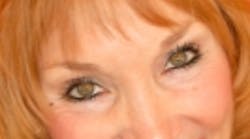By H. Chu Kim, DDS, MSPeriodontal disease affects nearly 75% of Americans and is the major cause of adult tooth loss. Due to the chronic nature of the disease, most patients fail to realize the disease process is actively happening within their mouth. It is not uncommon for a patient to be referred to a periodontist to treat the moderate to advanced problems, which could involve isolated to generalized areas throughout the mouth. Often, by this point,
periodontal disease is so advanced that it requires surgery — traditionally performed with the “open flap” method.Talking to a patient about peeling his or her gums back and then suturing them is not the most pleasant appointment. The periodontal practice of Greater Houston Dental Specialists (GHDS) uses much of the initial appointment to ensure the patient is thoroughly aware of how the disease advanced, what can be done to correct the problem, and what can be done to maintain the mouth and gums in the future. Generally, once the patient understands the concept of periodontitis and how it affects overall health, he or she is more willing to accept treatment. No patient wants to develop infections in their jawbone. However, treatment is traditionally a long process with a painful recovery time and a risk of postoperative complications, which puts prospective patients ill at ease and can sometimes deter them from surgery altogether.Recently, GHDS acquired the
PerioLase® MVP-7, a variable pulsed Neodymium:Yttrium-Aluminium-Garnet (Nd:YAG) dental laser. This laser has significantly changed how patients react to treatment, and its pain-free and quick recovery benefits have eased many patient concerns that surface when initially told they need to have periodontal surgery. The device performs the “Laser Assisted New Attachment Procedure” (LANAP), approved by the FDA for creating “cementum-mediated periodontal ligament new-attachment to the root surface in the absence of long junctional epithelium” (FDA K030290). It is the only laser that has been approved for this patented and FDA-approved periodontal protocol and is used to treat moderate to severe chronic periodontitis. To add to its benefits, the PerioLase
® has a higher bacterial kill rate than continuous wave (CW) or gated pulsed 810 diode lasers, has high selectivity in removing the diseased tissue from the tooth pocket, and is able to help form a stable clot within the pocket to seal off the site (similar to a root canal). The PerioLase
® has adjustable settings that allow it to be used for second-stage implant surgeries, gingivectomies, frenectomies, biopsies, hemostasis, and other procedures. This enables the periodontal practice at GHDS to offer pain-free options to correct periodontal disease with the confidence of obtaining the same or better results than with traditional flap surgery. Additionally, there is no need for bone grafting, membrane, growth factors, and sutures — translating into overall cost savings for the patient. To date, many practices justify the cost of LANAP (one of the most expensive treatments for periodontal surgery) as this latest technology in treating periodontal disease is virtually painless and nearly eliminates the risk of developing sensitive teeth and gum recession postoperatively. Like other acquisitions, the decision process to incorporate a PerioLase
® into the periodontal practice at GHDS has been a long and well-thought-out assessment, with the ultimate goal of adding the device only if it had a proven track record in the field and benefitted the patient’s overall dental health and comfort. For example, digital radiograph (including CT technology) has increased dentists’ ability to detect caries or changes in the jawbone while significantly reducing the exposure of radiation to the patient. Utilizing Piezosurgery
® has allowed bone to be cut precisely and safely with minimal trauma to soft tissues. In addition, biological advancements have helped to reduce patient morbidity and discomfort through working with growth factors and stem cells (not embryonic). These advancements have helped to provide the best possible outcome for periodontal patients. The ultimate decision to acquire a PerioLase
® occurred after it was clear that not only would the patient benefit, but that the return on investment would be justified as well. The periodontal practice at GHDS does not charge for second-stage procedures — and as a scalpel works faster on frenectomies, it did not make economic sense for the practice to acquire the laser early on. However, in 2007 a research paper was published in the
International Journal of Periodontics and Restorative Dentistry that showed human histology of new cementum and new connective tissue attachment following the LANAP procedure performed by a PerioLase
®. After thorough discussion with other leading periodontists who utilized the laser, it became apparent that the device could potentially replace day-to-day periodontal surgeries to efficiently treat inflammatory periodontal disease at a cost that was beneficial for both the practice and the patient — and included the added benefit of encouraging more patients to undergo treatment when needed. Another benefit the PerioLase
® adds to a practice is the extensive training provided (and required) with its acquisition. The developers of the laser, Millennium Dental Technologies, express significant concern about how clinicians use their product and have developed standardized training, calibrating everyone involved from the researchers to the clinicians, to ensure the laser is used safely and to its full potential. A practice is not able to acquire a PerioLase
® until the potential users of the laser attend a three-day extensive laser training that covers laser physics to clinical application of the device. The final day incorporates a live patient, hands-on training. At the six-month and 12-month marks, clinicians go back to the training site to review procedures and learn more information about the full capabilities of the laser. The PerioLase
® has enhanced the overall care of patients at GHDS, a practice that focuses on the comprehensive treatment of patients through advances in periodontal, restorative, and prosthetic dentistry. With the option of offering LANAP, treatment options are easier to evaluate and make a patient’s decision less stressful, as well as decrease anxiety during the actual procedure. When patients at GHDS hear there is an option that requires no cutting and no suturing, they generally give sighs of relief. This often overshadows the fact that this treatment also eliminates recessions and sensitive teeth — just as crucial when weighing the pros and cons of treatment. Laser use, particularly the use of a PerioLase
®, has gone through a paradigm shift and made a significant impact on the options patients have for periodontal treatment. It has served the practice of GHDS in many ways, including exposing implants and conducting frenectomies on patients, justifying its up-front cost and becoming a valuable asset to the practice.







